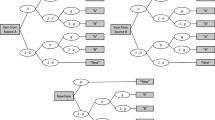Abstract
Nonlinear latent variable models are specified that include quadratic forms and interactions of latent regressor variables as special cases. To estimate the parameters, the models are put in a Bayesian framework with conjugate priors for the parameters. The posterior distributions of the parameters and the latent variables are estimated using Markov chain Monte Carlo methods such as the Gibbs sampler and the Metropolis-Hastings algorithm. The proposed estimation methods are illustrated by two simulation studies and by the estimation of a non-linear model for the dependence of performance on task complexity and goal specificity using empirical data.
Similar content being viewed by others
References
Anderson, T. W. (1984).An Introduction to multivariate statistical analysis (2nd ed.). New York: Wiley.
Arminger, G., & Schoenberg, R. J. (1989). Pseudo maximum likelihood estimation and a test for misspecification in mean and covariance structure models.Psychometrika, 54, 409–425.
Arminger, G., Wittenberg, J., & Schepers, A. (1996).MECOSA3 User Guide. Friedrichsdorf, Germany: ADDITIVE GmbH.
Arnold, S. F. (1993). Gibbs Sampling. In C. R. Rao (Ed.),Handbook of statistics (Vol. 9, pp. 599–625). Amsterdam: North Holland.
Besag, J., Green, P., Higdon, D., & Mengersen, K. (1995).Bayesian computation and stochastic systems.Statistical Science, 19(1), 3–66.
Box, G. E. P., & Tiao, G. C. (1973).Bayesian inference in statistical analysis. Reading: Addison-Wesley.
Browne, M. W. (1984). Asymptotic distribution-free methods for the analysis of covariance structures.British Journal of Mathematical and Statistical Psychology, 37, 62–83.
Carlin, B. P., & Louis, T. A. (1996).Bayes and empirical bayes methods for data analysis. London: Chapman & Hall.
Casella, G., & George, E. I. (1992). Explaining the Gibbs sampler.The American Statistican, 46, 167–174.
Chib, S., & Greenberg, E. (1995). Understanding the Metropolis-Hastings algorithm.The American Statistican, 49(4), 327–335.
Chib, S., & Greenberg, E. S. (1996). Markov chain Monte Carlo simulation methods in econometrics.Econometric Theory, 12(3), 409–431.
Early, P. C., Lee, C., & Hanson, L. A. (1990). Joint moderating effects of job experience and task component complexity: relations among goal setting, task strategies, and performance.Journal of Organizational Behavior, 11, 3–15.
Gelfand, A. E., & Smith, A. F. M. (1990). Sampling-based approaches to calculating marginal densities.Journal of the American Statistical Association, 85, 398–409.
Gelman, A., Carlin, J. B., Stern, H. S., & Rubin, D. B. (1995).Bayesian data analysis. London: Chapman & Hall.
Gelman, A., & Rubin, D. B. (1992). Inference from Iterative Simulation Using Multiple Sequences (with discussion).Statistical Science, 7, 457–511.
Geman, S., & Geman, D. (1984). Stochastic relaxation, Gibbs distribution and the Bayesian restoration of images.IEEE Transactions on Pattern Analysis and Machine Intelligence, 6, 721–741.
Gilks, W. R., Richardson, S., & Spiegelhalter, D. J. (1996).Markov chain Monte Carlo in practice, London: Chapman and Hall.
Härdle, W. (1990).Applied nonparametric regression. Cambridge, MA: Cambridge University Press.
Hastings, W. K. (1970). Monte Carlo sampling methods using Markov chains and their applications.Biometrika, 57, 97–109.
Hayduk, L. A. (1987).Structural equation modeling with LISREL: Essentials and advances. Baltimore, MD: Johns Hopkins Press.
Hobert, J. P., & Casella, G. (in press). The effect of improper priors on Gibbs sampling in hierarchical linear mixed models.Journal of the American Statistical Association.
Holling, H. (1995).Goal setting and performance. Unpublished manuscript, Universität Münster, Department of Psychology, Germany.
Jöreskog, K. G., & Sörbom, D. (1993).LISREL 8: Structural equation modeling with the SIMPLIS command language. Hillsdale, NJ, Lawrence Earlbaum Associates.
Jöreskog, K. G., & Yang, F. (1996). Nonlinear structural equation models: The Kenny-Judd model with interaction effects. In G. A. Marcoulides, & R. E. Schumacker (Eds.),Advanced structural equation modeling techniques (pp. 57–88). Hillsdale, NJ, Lawrence Erlbaum Associates.
Kenny, D., & Judd, C. M. (1984). Estimating the nonlinear and interactive effects of latent variables.Psychological Bulletin, 96, 201–210.
Lawley, D. N., & Maxwell, A. E. (1971).Factor analysis as a statistical method. London: Butterworth.
Lee, S. Y. (1991). A Bayesian Approach to Confirmatory Factor Analysis.Psychometrika, 46, 153–160.
Lindley, D. V., & Smith, A. F. M. (1972). Bayes estimates for the linear model (with discussion).Journal of the Royal Statistical Society, Series B, 34, 1–41.
Loftsgaarden, D. O., & Quesenberry, G. P. (1965). A nonparametric estimate of a multivariate density function.Annals of Mathematical Statistics, 36, 1049–1051.
MacEachern, S. N., & Berliner, M. L. (1994). Subsampling the Gibbs sampler.The American Statistican, 48, 188–190.
Metropolis, N., Rosenbluth, A. W., Rosenbluth, M. N., Teller, A. H., & Teller, E. (1953). Equations of state calculations by fast computing machines.Journal of Chemical Physics, 21, 1087–1091.
Müller, P. (1994). Metroplis Based Posterior Integration Schemes. Unpublished manuscript, Duke University, Durham.
Muthén, B. O. (1988).LISCOMP—Analysis of linear structural equations with a comprehensive measurement model. Mooresville: Scientific Software.
Press, S. J., & Shigemasu, K. (1989). Bayesian inference in factor analysis. In L. Gleser, M. D. Perlman, S. J. Press, & A. R. Sampson (Eds.),Contributions to probability and statistics (pp. 271–287). New York: Springer Verlag.
Ritter, C., & Tanner, M. A. (1992). Facilitating the Gibbs sampler: The Gibbs stopper and the Griddy-Gibbs sampler.Journal of the American Statistical Association, 87, 861–868.
Rubin, D. B. (1991). EM and Beyond.Psychometrika, 56, 241–254.
Tanner, M. A. (1993).Tools for statistical inference (2nd ed.). Heidelberg and New York: Springer Verlag.
Tierney, L. (1994). Markov chains for exploring posterior distributions (with Discussion).Annals of Statistics, 22, 1701–1762.
Author information
Authors and Affiliations
Additional information
The first author is indebted to the Graduate School of Education and Information Studies at UCLA for providing a visiting professorship during the winter quarter 1994. The work of the first author was supported by a grant from the Deutsche Forschungsgemeinschaft. The work of the second autho was supported by grant 1K02AA00230-01 from NIAAA and by grant 40859 from NIMH to C. Hendricks Brown's Prevention Science Methodology Group. The authors thank Donald Rubin and C. Hendricks Brown for a critical reading of the first draft of the paper. They are especially grateful for the technical assistance of Jörg Wittenberg of the Bergische Universität Wuppertal who designed the program BALAM (Bayesian Analysis of Latent Variable Models). The data for the empirical example have been generously provided by Heinz Holling of the University of Münster, Germany. The authors are indebted to an associate editor and to three anonymous reviewers of Psychometrika whose criticisms, comments and suggestions have been very helpful.
Rights and permissions
About this article
Cite this article
Arminger, G., Muthén, B.O. A Bayesian approach to nonlinear latent variable models using the Gibbs sampler and the metropolis-hastings algorithm. Psychometrika 63, 271–300 (1998). https://doi.org/10.1007/BF02294856
Issue Date:
DOI: https://doi.org/10.1007/BF02294856




